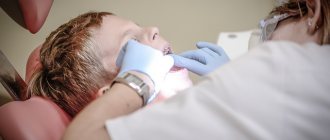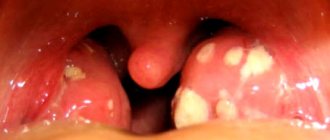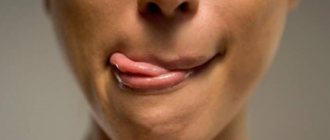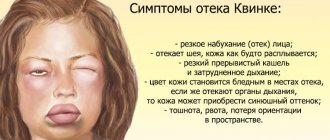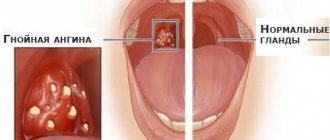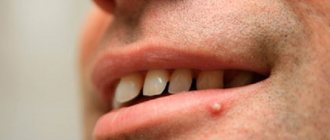Plugs in the palatine tonsils (or tonsils) are purulent accumulations in the lacunae of the tonsils. In medicine you can find other names for this pathology: purulent plugs, caseous plugs.
Most corks are white, but can have a yellow, brown or gray tint, depending on their composition.
Tonsil plugs may be soft to the touch or harder if they contain a large amount of calcium. Their size varies from a few millimeters to a centimeter. Both men and women are equally susceptible to their appearance, regardless of age.
Some patients mistakenly think that this condition does not need to be treated. But this is fundamentally wrong! The presence of purulent accumulations in the palatine tonsils contributes to the development of complications (not only in the upper respiratory tract, but even in the joints, kidneys and heart!).
Why does an accumulation of pus occur in the tonsils? How to treat tonsil plugs? And is it possible to carry out treatment at home? You will find answers to all your questions in our new article.
Structure of the tonsils
The palatine tonsils, or tonsils, are an important organ of the human immune system. The tonsils are located in the oral cavity on both sides of the pharynx. The tonsils are shaped like an almond (hence the name “almond”) and range in size from one to four centimeters in diameter. The tonsils are endowed with a protective function. They are a kind of barrier to bacteria entering the body through airborne droplets, as well as through food intake. The structural features of the tonsils and the functions they perform are directly related to the appearance of tonsillitis plugs in the throat.
Make an appointment right now!
Call us by phone or use the feedback form
Sign up
On the surface of the tonsils, winding canals and openings are visible - lacunae and crypts.
When viruses from the outside enter the mouth, leukocytes in the tonsils are activated and begin an intensified process of forming antibodies that fight the “enemy.” At the same time, a signal is sent to all organs of the immune system, and the body comes into “combat readiness”.
What is tonsillitis?
Tonsillitis is an inflammatory process in the tonsils. The disease can be acute or chronic. The acute form is better known as tonsillitis. In chronic cases, periods of exacerbation (inflammation of the tonsils) are replaced by a period of remission (calm). Most often, the disease occurs in children 5-15 years old, although adults are also susceptible to the disease. The tonsils in children are larger than in adults. The palatine tonsils reach their maximum size by the age of 7, and then begin to shrink. Constant viral attacks on the tonsils lead to tonsillitis. Chronic tonsillitis most often acts as a complication after an infectious disease (sore throat, caries, etc.). The chronic form of the disease, according to statistics, occurs in 5% of adults and 11% of children. That is, chronic tonsillitis is a common disease. Tonsillitis plugs on the tonsils often appear with chronic tonsillitis.
Causes of chronic tonsillitis
The chronic form of tonsillitis often develops as a complication after a sore throat. Many patients try to cure a sore throat on their own and take medications uncontrollably. Some, having received doctor’s recommendations, do not follow the instructions and finish the course of taking antibacterial drugs earlier than expected, noticing an improvement. This is a huge mistake! Untreated sore throat causes the disease to enter the chronic stage and the formation of tonsillitis with purulent plugs. The main causative agents of the disease are streptococci and staphylococci.
Exacerbation of tonsillitis is favored by:
- chronic inflammatory process (sinusitis, caries, sinusitis, etc.);
- proliferation of adenoids;
- deviated nasal septum;
- damage to the tonsils;
- hypothermia;
- weak immunity.
Prevention
To avoid the appearance of tonsillitis plugs, you need to follow simple preventive rules:
- Treat inflammatory diseases in a timely manner, avoiding exacerbations (tonsillitis, sore throat, caries, etc.).
- Maintain oral hygiene (timely brushing, removing food debris).
- Avoid hypothermia and dress appropriately for the weather.
- Do not use other people's personal hygiene items (toothbrush, toothpaste, etc.).
- Strengthen the immune system (through proper nutrition, hardening the body, taking vitamins, etc.).
Tonsillitis plugs are a severe inflammatory disease that causes pain and discomfort to a person. Therefore, at the first symptoms of inflammation (sore throat, sensation of a foreign object in the mouth, etc.), you should consult a doctor. Removing plugs on your own and taking medications uncontrolled can only cause harm. To speed up the healing process, both medications and folk remedies can be used as therapy. But it’s even better to prevent the appearance of purulent plugs and treat existing pathologies in a timely manner.
- Atlas of Oral Diseases / Robert P. Langlais, Craig S. Miller. — M.: GEOTAR-Media
- Polunina T.A.
Tonsillectomy in children // Issues of modern pediatrics. — 2012 - Galina Kolosenko.
.
Health
. Arguments and Facts
Why do traffic jams occur with tonsillitis?
The main factor in the formation of purulent plugs on the tonsils is the constant presence of a focus of inflammation, provoked by viruses. There are always bacteria in the human mouth - they are not dangerous to health. Once in the gaps, they are killed by immune cells. The tonsils of a healthy person are capable of self-cleaning - dead microorganisms are removed from the lacunae and enter the stomach with saliva, where they are destroyed under the influence of gastric juice.
But as soon as dangerous viruses enter the body, a large number of leukocytes are sent to fight them, the mucous membrane of the tonsils swells, and self-cleaning of the lacunae under such conditions becomes difficult. Dead bacteria and leukocytes begin to accumulate in the tonsils - purulent-caseous formations appear. If you do not consult an otolaryngologist in time and do not begin treatment for purulent tonsillitis plugs, the process can become irreversible and lead to the destruction of the tonsils.
Purulent formations and chronic tonsillitis
In the chronic form of the disease, inflammation in the tonsils does not completely disappear, but only subsides for a while. Bacteria are always present in the lacunae of the tonsils, and the increased formation of a large number of leukocytes does not stop. Since the chronic form is characterized by the absence of pronounced signs of the disease, the appearance of purulent plugs goes unnoticed by the patient. White blood cells surround the bacteria, and a purulent formation appears. Over time, substances containing calcium and magnesium accumulate in them. As a result, the plugs harden.
Among the reasons for the formation of traffic jams are:
- diseases of the nasal cavity that are chronic (for example, sinusitis) - some of the bacteria from the nose certainly gets into the throat;
- lack of proper oral hygiene - here bacteria are constantly present and when immunity decreases, they enter the tonsils; food debris can also get stuck in the gaps and become “material” for the hardening of purulent masses;
- weak immunity - a person is unable to cope with the infection on his own, and the disease becomes protracted or chronic;
- damage to the tonsils - infection can easily get into the wound. Often it is the site of injury that becomes the location of a new purulent formation.
Prevention of relapse
Preventing the recurrence of traffic jams is a set of measures. The patient must be under dispensary observation, that is, the patient must be periodically examined by an otolaryngologist in medical institutions for a certain time.
The patient must undergo courses of anti-relapse therapy. Together with the doctor, it is necessary to ensure that the patient does not have a sore throat. This is a very large amount of work, and it is performed by an otolaryngologist.
These include: local lavage of the tonsil outlets, various local anti-inflammatory drugs, physical therapy. All complex treatment is aimed at stopping relapses of the disease.
A patient may suffer for years from the appearance of plugs in the throat, but here you need to understand that they will continue to appear until the person takes treatment and undergoes the whole range of procedures. After which it will be necessary to constantly prevent the occurrence of inflammation in the tonsils in order to forget about this disease forever.
//www.youtube.com/watch?v=cxKte7uuRkw
Symptoms of purulent plugs in the throat
Traffic jams are a factor by which chronic tonsillitis can be recognized. Therefore, when traffic jams appear, all the signs of this chronic disease are present. The following symptoms can be identified during an exacerbation of tonsillitis.
Constantly recurring sore throats - if there is inflammation in the tonsils, then this is not an indicator of chronic tonsillitis. But if a person is susceptible to the disease more than two or three times a year, then we can confidently say that we are dealing with a chronic form of the disease.
Friends! Timely and correct treatment will ensure you a speedy recovery!
The next symptom is redness and swelling of the palatine arches, to which inflammation from the tonsils can spread. Adhesions can form between the palatine arches and the tonsils - they seem to stick together with each other.
Enlarged lymph nodes are another sign of the disease. The manifestation of tonsillitis is accompanied by elevated body temperature. In the chronic form, a temperature of 37°C can last from several days to several weeks. The patient feels constant fatigue, lethargy, and performance decreases. All these are signals of adverse changes occurring in the body.
Symptoms of purulent plugs in the throat
The first sign is a feeling that there is something in the throat: like a lump; A dry cough may accompany these unpleasant sensations. The patient has difficulty swallowing and has a sore throat.
Severe pain in the throat is accompanied by a putrid odor from the mouth, which cannot be muffled even with the help of toothpastes. This smell is the result of the activity of bacteria accumulated in traffic jams. Caseous formations are also visible upon visual inspection - curdled tubercles of a white-yellow hue are immediately noticeable on the tonsils. It happens that the pustules are not immediately visible, but as soon as you press on the surface of the tonsil, for example, with your tongue, these white-yellow tubercles begin to appear.
Blockages in the tonsils can bring a lot of unpleasant and even dangerous consequences to the patient: if the infection travels with the blood or lymph flow further through the body, it can cause problems with the heart, kidneys and joints. In order not to have to treat complications from tonsillitis, it is necessary to get an appointment with an otolaryngologist in a timely manner and begin treatment for tonsillitis with purulent plugs.
How to remove it yourself at home? Is it possible?
Official medicine does not recommend cleaning tonsils by any mechanical means.
This can lead to injury to the mucous membrane, bleeding and further aggravation of the situation,
Very dangerous complications may also occur.
However, in various sources you can find different ways to squeeze out pus from the tonsils. For example:
- tongue;
- using a cotton swab;
- by washing.
The most physiological way is to remove lumps with the tongue. They try to press as hard as possible on each of the tonsils so as to loosen them and squeeze them into the mouth.
This method is quite safe and does not lead to disruption of the integrity of the mucous membrane. But at the same time, it is insignificantly effective, since only sometimes it allows you to remove small surface deposits or particles thereof.
A much more effective way to eliminate pus from the throat is to use cotton swabs.
But you need to immediately focus on the fact that its use can lead to injuries, penetration of microbes deeper into tissues and complications, the most dangerous of which is sepsis. If you don’t have time to contact an ENT specialist and the risk of such consequences does not scare you, you should start the procedure no earlier than a couple of hours after eating
Immediately before it, you need to brush your teeth and rinse your mouth thoroughly.
To remove the lump, take a cotton swab and apply it to the base of one of the tonsils, while pulling the cheek to the side. Gradually, without sudden jerks or great effort, the tampon is moved upward.
It is allowed to repeat this manipulation no more than 2-3 times, and only when they pass without pain. If as a result of this the ball does not come out, you should stop any independent attempts to remove it and consult a doctor.
Removal method: video
https://youtube.com/watch?v=oeL9lOr1ZiQ
A fairly safe method of solving the problem is to wash the tonsils with solutions of antiseptic substances. You can choose among them:
- weak saline or alkaline aqueous solution (1 teaspoon of salt or soda per 100 g of warm water);
- Furacilin solution;
- Iodinol;
- Miramistin;
- Chlorhexidine.
To clear the throat of blockages, the selected solution is drawn into a syringe from which the needle has previously been removed, the head is tilted back and the liquid is applied to the tonsil.
In this case, you should try to keep the syringe close to the surface of the organ, but so as not to damage the mucous membrane.
The solution is irrigated not only on the affected areas, but also on the palatine arches, and they hold it in the mouth for several seconds and only then spit it out. The procedure is repeated 2-3 times.
Treatment of tonsillitis plugs
The appearance of plugs indicates long-term inflammation occurring in the body, so the removal of purulent plugs must be combined with measures to treat chronic tonsillitis. Chronic tonsillitis should be treated by a competent otolaryngologist. Only an ENT doctor knows how to treat tonsillitis plugs effectively and safely. There is no need to try to get rid of pustules on your own at home. Many patients begin to put pressure on the tonsils, scraping off the “plaque” with a spoon and other improvised means. But this measure is ineffective - pus is removed only from the surface, but this is only the tip of the iceberg, the main problem is inside. Such inept actions often lead to injury to the tonsils, which will only provoke the appearance of new caseous formations.
Features of therapy
An ENT doctor, primary care physician or pediatrician will tell you how to treat emerging ulcers. First of all, it is necessary to determine the causes of the pathological condition, so that therapy includes not only symptomatic treatment, but also etiotropic treatment (aimed at destroying the pathogen).
If the cause of ulcers is a bacterial infection, antibiotics are prescribed based on the results of determining the sensitivity of microbial cells. Preference is given to the following groups due to their low toxicity (allowed in the treatment of pregnant women and children):
- macrolides – Erythromycin, Clarithromycin, Sumamed;
- cephalosporins – Cefotaxime, Cephalexin, Cefodox;
- penicillins – Ampicillin, Oxacillin, Ampiox.
Antibacterial agents can be used in the form of tablets, injections, and also in the form of aerosols for local therapy. Probiotics (Lactobacterin, Bifiform, Acylact) and prebiotics (Prelax, Hilak forte, Romfalak) are prescribed with antibiotics to prevent dysbacteriosis and pharyngomycosis.
Aspirin or Ibuprofen is taken to prevent possible complications from the heart and joints. Vitamin complexes are prescribed without fail to strengthen the body's defenses.
Washing the tonsils
The doctor will tell you how to wash the tonsils and how to remove the pathological plaque.
Washing tonsils in the clinic
This is necessary to reduce the number of pathogens and relieve symptoms of intoxication. You can use infusions and decoctions of medicinal herbs, as they have antiseptic properties:
To prepare the solution you need one component or a combination of several. Two tablespoons of raw material are poured into a liter of boiling water and left for several hours. Do not use a hot solution. Rinse the tonsils with a syringe, without using a needle, about 5-7 times a day.
A solution of sea salt (5 g per glass of liquid) will help cure your throat. The course of therapy is a week, 3 times a day. You can also wash the lacunae with Miramistin, Furacilin, Chlorophyllipt.
Rinsing
Used for the treatment and prevention of inflammatory processes. Gargling and gargling of tonsils should be done every 3 hours, alternating with other procedures. How to gargle:
- Beetroot juice. Beetroot is used in its unpeeled form. You need to chop one vegetable and add water. Keep on low heat for at least 60 minutes. Next, strain.
- Yarrow decoction with honey.
- Sage tea.
- Garlic-propolis solution. Pour 3 crushed cloves with a glass of boiling water, after an hour of infusion, add a teaspoon of propolis tincture.
- Lemon juice diluted with water (1 part juice to 5 parts liquid).
These fortified mixtures are not intended to remove ulcers, but they will strengthen the immune system and speed up recovery.
Recipe No. 1. Combine a glass of kefir, lemon juice (half the fruit), 3 tbsp. l. beet juice and 1 tsp. rosehip syrup. Allowed upon reaching 7 years of age.
Recipe No. 2. Pour a glass of boiling water over the crushed dry raspberry branch and leave for 15 minutes. After straining, add a little linden honey.
Treatment of ulcers in the throat is possible using inhalations. Such procedures can relieve the symptoms of the underlying disease, reduce pain and hyperemia. It is advisable that inhalations be carried out through a nebulizer. The following means are used:
- Miramistin;
- Furacilin;
- Cromohexal;
- Chlorophyllipt;
- saline;
- alkaline mineral waters.
Your doctor will tell you how to treat a particular disease that causes ulcers in the throat and tonsils. When choosing a treatment regimen, the patient's age is taken into account. Self-medication is unacceptable, as it can lead to generalization of the pathological process, prolonged recovery of the body and the development of a number of serious complications.
Conservative method of removing tonsillitis plugs
Conservative treatment consists of:
- Treatment with medications (antibiotics and the duration of treatment is prescribed directly by the ENT doctor. Treatment of chronic tonsillitis should begin at the time of exacerbation, not remission. As a rule, the patient is prescribed the drugs “Amoxicillin”, “Amoxiclav”, “Summamed”, “Azithromycin”, etc. .).
- Gargling (solutions of furatsilin, soda, decoctions of chamomile, St. John's wort, string, from pharmaceutical products - Miramistin, Rotokan, etc. are excellent).
- Inhalations (as agreed with the doctor).
- Rinsing the lacunae of the tonsils (the most effective method for removing purulent accumulations. Performed only by an otolaryngologist. Rinsing is carried out using a syringe or a TONZILLOR device.
When carrying out a course of rinsing, the patient's condition significantly improves, the tonsils look healthier, and are cleared of purulent accumulations.
With chronic tonsillitis, the period of remission of the disease increases.
Use of antibiotics
Antibiotics are prescribed in case of purulent processes in the tonsils in order to stop the further spread of infection. As a rule, the drug is selected after taking a smear from the tonsils and determining the sensitivity of the bacteria living in it to certain drug substances. The use of penicillin antibiotics (ampicillin, amoxiclav) is often recommended.
Sometimes the analysis is not carried out, and in this case broad-spectrum drugs belonging to the group of cephalosporins (ceftriaxone, suprax) or macrolides (sumamed, azithromycin) are prescribed. They are used as prescribed orally, administered locally to the tonsils or for inhalation.
Surgery
Tonsillectomy - removal of the tonsils - is the most radical way to get rid of the problem. It is used in the most extreme cases, when conservative methods do not bring the desired relief, and the indications for surgery must be quite serious. Before removing tonsils, you need to carefully weigh everything and first try a full range of conservative treatment measures. By removing the tonsils, you are deprived of a natural natural barrier against viruses and infections. You need to fight to preserve your tonsils to the last!
Tonsils are removed using a scalpel, laser or liquid nitrogen. Your ENT doctor will definitely tell you about all the intricacies and consequences of tonsillectomy.
Traditional medicine and preventive measures
Treatment with folk remedies for removing accumulated pus is not entirely effective - plugs located deep in the tonsil cannot be removed. With their help, you can only soften the surface of the plugs to facilitate their rejection and use herbal decoctions when gargling and disinfecting it.
To reduce the risk of traffic jams, you need to follow some simple tips:
- carefully monitor oral hygiene;
- treat sore throat and inflammation in the nose and mouth in a timely manner: sinusitis, frontal sinusitis, caries, stomatitis;
- avoid hypothermia;
- for chronic tonsillitis, follow the recommendations of your ENT doctor, do not forget about preventive complexes of physiotherapy and tonsil rinsing;
- Strengthen your immune system and try to lead a healthy lifestyle.
Vacuum rinsing of tonsils stages:
- The doctor performs anesthesia by spraying the tonsils with a solution of lidocaine.
- An Atmos vacuum cap is applied to the palatine tonsils one by one.
- Within 30 seconds, plugs and pus are pumped out of the lacunae (recesses in the tonsil) under the influence of vacuum.
- At the same time, under pressure, the lacunae are washed with an antiseptic, selected individually based on previously performed tests.
- The doctor checks the cleanliness of the tonsils under a microscope. If necessary, spot flushing is performed.
- Using special Atmos sprayers, the doctor treats the tonsils with antiseptics.
The duration of the procedure is 5 minutes. Easily tolerated by patients. You can eat and drink after half an hour.
Vacuum rinsing of tonsils price - 1800 rubles. A unique procedure at an unbeatable price! Anesthesia - 500 rubles, treatment with antiseptics - 1000 rubles.
Treatment at the ENT Clinic of Doctor Zaitsev
Many years of experience of our doctors allows us to say with confidence that treating chronic tonsillitis is our specialty. The modern equipment of the clinic allows for effective and safe manipulations to treat tonsillitis and remove purulent plugs. Washing of the tonsils is carried out using all methods known in practice, including using a modified TONSILLOR nozzle, which has no analogues in other medical institutions. This is the know-how of our clinic. The modified attachment is much more effective than the usual one, completely safe, its use does not cause pain to the patient and is suitable even for small children.
Please make an appointment and come. We will be happy to help you.

